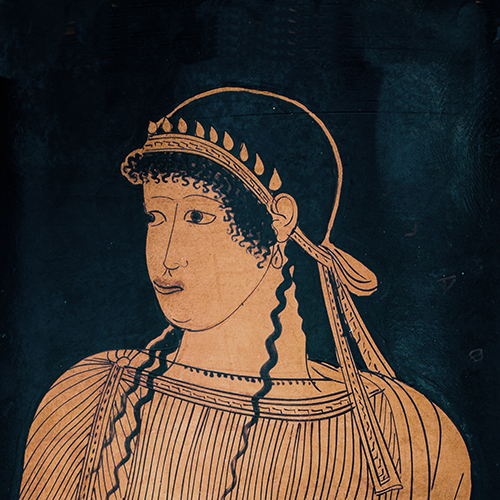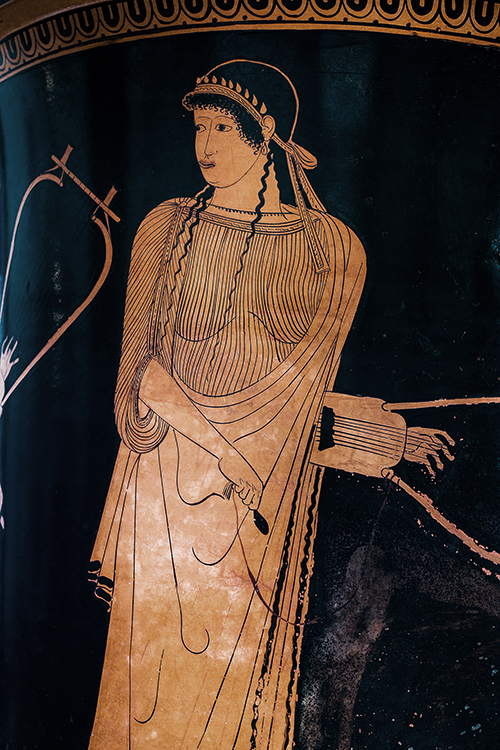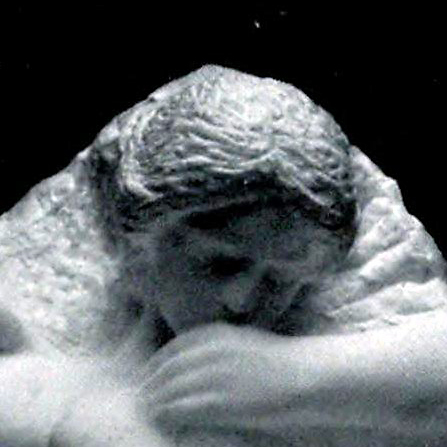2021.07.12 | By Gregory Nagy
§0. Reading the words of Sappho’s songs, we cannot picture her looks, that is, we cannot imagine what she looked like—I say it here in colloquial English. But we can readily imagine what she looked at—especially the beautiful things, the beautiful people. In this essay, I can show that Sappho’s looks in the ancient world—the way she looked—could be pictured as a mirroring of the way she looked at beauty. For examples, I will focus on two faces. The first example comes from visual art. It is the face of a beautiful young woman painted on an Athenian vase produced in the early fifth century BCE. For my introductory illustration, I show a close-up, at the end of this paragraph. We see here a beautiful woman who is identified, by lettering painted next to her, as Sappho. As for the second example, it comes from verbal art—from a song of Sappho. It is the face of another beautiful young woman, named Anaktoria, envisioned in Song 16 of Sappho. Relevant to my focusing on these two faces of two beautiful women is the Greek word prósōpon, which is actually used at line 18 of Song 16, and the face in this context belongs to Anaktoria, but the view of this face also belongs, indirectly, to the viewer of this face, who is the speaking “I” of Sappho. I say it this way because the Greek noun prósōpon, like the English verb look, can refer to a two-way stream of vision—you see what you look at through your own eyes and you can be seen as what you look like through the eyes of someone who looks back at you. In other words, the prósōpon both projects and reflects vision, and that is why this word means ‘mask’ as well as ‘face’, since ancient masks were conventionally viewed as projections of an identity other than yours, not concealments of your own identity.
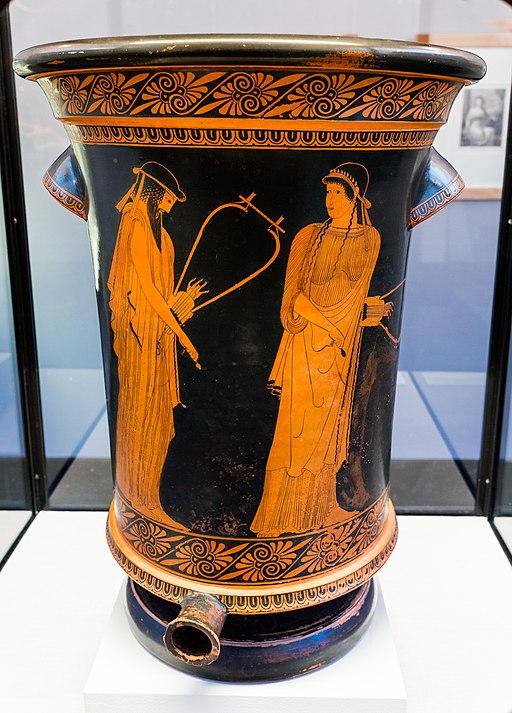
§1. In a previous essay, I have commented at length on the vase that featured this picture of Sappho, taking into account not only the pair of figures on one side, featuring Alcaeus on our left and Sappho on our right, but also the pairing on the other side, featuring the god Dionysus on our left making eye-contact with a “maenad” featured on our right (Nagy 2009, linked here, starting at p. 233). Here is a picture of the other side:

§2. I focus for the moment on the fact that the face of Sappho on one side of the vase is seen at three-quarter view, as art historians would describe it—unlike the profiled face of the “maenad” painted on the other side of the vase, whose eyes are riveted on the eyes of Dionysus. The god’s eyes, with his profile facing hers, are compellingly attracting her gaze. In my previous essay, as just cited, I asked myself about the contrasting three-quarter view of Sappho’s face: is she about to turn into a full profile, turning toward the attractive man who is courting her—and who is identified by lettering painted next to him as Alcaeus, master of lyric songmaking—or is she about to turn away from him and look full-frontal toward the viewer, face-to-face?
§3. The indirectness of Sappho’s looks in this painting reminds me of a sculpture, now lost, by Auguste Rodin, which pictures Sappho looking away from her viewer, looking sadly downward into the shadow cast by her three-dimensional self. I show here a photograph that has survived, starting with a close-up of her sad face and then following up with a full view:
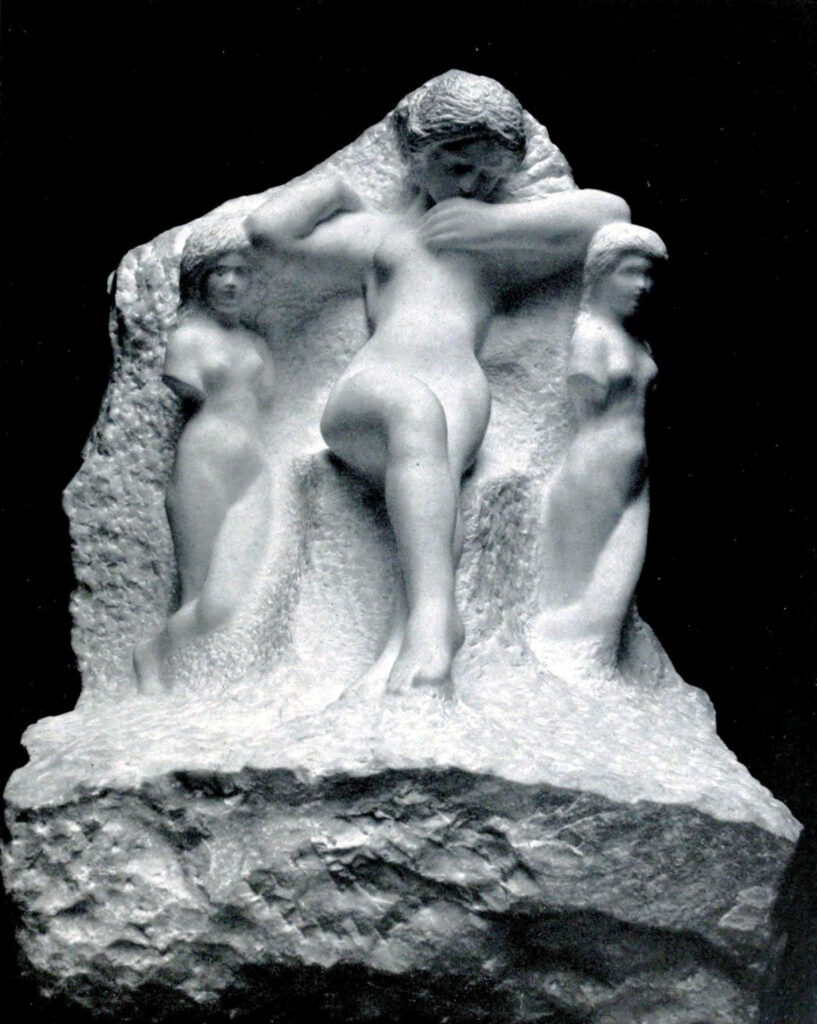
§4. As indicated in the caption for the full view of the old photograph of this piece of sculpture, the original work is now lost. The image shown here also graces the front cover of The Cambridge Companion to Sappho, edited by P. J. Finglass and Adrian Kelly (2021). The caption for it in that book of collected essays reads (p. xvi): “Location unknown: photo © Alamy Images.” That is all we are told. More could have been said. As indicated in the caption that I offer above, this work of art was looted from the collection of Hans Rudolf Fürstenberg (1890–1982) and is now presumed lost, perhaps forever. And the victim of this looting, it is no coincidence, was of Jewish ancestry. In a sad sort of way, the sadness of Sappho mirrors here a poetics of loss, perhaps permanent loss.
§5. I return to the painting, and to my question, which I now ask again, but this time in terms of “looking away,” as I just described the looks of Sappho in the sculpture by Rodin. So, to ask the question again: is Sappho about to look at the singer who is singing a love song to her, turning toward him, or is she looking away from him? I see in this painting a poetics of distancing, where the looks of Sappho are distanced from an immediate situation. And I see a comparable poetics of distancing in Song 16 of Sappho, where the beautiful prósōpon or ‘look on the face’ of Anaktoria, signaled at line 18, is pictured as radiating its beauty, suffusing the whole song with its beautiful radiance as she dances—even though the sight of her has gone away, gone far away from the here-and-now, perhaps forever:
|1 [ο]ἰ μὲν ἰππήων ϲτρότον οἰ δὲ πέϲδων |2 οἰ δὲ νάων φαῖϲ’ ἐπ[ὶ] γᾶν μέλαι[ν]αν |3 [ἔ]μμεναι κάλλιϲτον, ἔγω δὲ κῆν’ ὄτ-|4-τω τιc ἔραται· |5 [πά]γχυ δ’ εὔμαρεc ϲύνετον πόηϲαι |6 [π]άντι τ[ο]ῦ̣τ’, ἀ γὰρ πόλυ περϲκέ̣θ̣ο̣ι̣σ̣α |7 κ̣άλ̣λο̣c̣ [ἀνθ]ρ̣ώπων Ἐλένα [τὸ]ν ἄνδρα |8 τ̣ὸν̣ [πανάρ]ιϲτον |9 κ̣αλλ[ίποι]σ̣’ ἔβα ’c Τροΐαν πλέοι̣[ϲα |10 κωὐδ[ὲ πα]ῖδοc οὐδὲ φίλων το[κ]ήων |11 π̣ά[μπαν] ἐμνάϲθη, ἀλλὰ παράγ̣α̣γ̣’ α̣ὔταν |12 [. . .]ϲαν [. . .] |15 [. .]μ̣ε̣ νῦν Ἀνακτορί[αc ὀ]ν̣έ̣μναι-|16 [-ϲ’ οὐ ] παρεοίϲαc, |17 [τᾶ]c <κ>ε βολλοίμαν ἔρατόν τε βᾶμα |18 κἀμάρυχμα λάμπρον ἴδην προϲώπω |19 ἢ τὰ Λύδων ἄρματα †κανοπλοιϲι |20 [πεϲδομ]άχενταc.
|1 Some say a massing of chariots and their drivers, some say of footsoldiers, |2 some say of ships, if you think of everything that exists on the surface of this black earth, |3 is the most beautiful thing of them all. But I say it is that one thing |4 that anyone passionately loves [erātai]. |5 It’s really quite easy to make this understandable |6 to everyone, this thing. You see, that woman who was by far supreme |7 in beauty among all mortals, Helen, |8 she [. . .] left her best of all husbands, |9 him she left behind and sailed to Troy, |10 caring not about her daughter and her dear parents, |11 not caring at all. She was swept along [. . ] |15 [All this] reminds me right now of Anaktoria. |16 She is [not] here. |17 Oh, how I would far rather wish to see her taking a dancing-step that-arouses-passionate-love [= eraton], |18 and to see the luminous radiance from the look-on-her-face [prósōpon] |19 than to see those chariots of the Lydians and the footsoldiers in their armor |20 as they fight in battle [. . .].
Sappho Song 16
Bibliography
Bierl, A., ed. 2021. Sappho: Lieder. With translation and commentary. Ditzingen (the “Reclam” series).
Calame, C. 1991. “‘Mythe’ et ‘rite’ en Grèce: des catégories indigènes?” Kernos 4:179–204. Reprinted in Calame 2008:43–62.
Calame, C. 2008. Sentiers transversaux. Entre poétiques grecques et politiques contemporaines, ed. D. Bouvier, M. Steinrück, and P. Voelke. Grenoble.
CS. See Finglass and Kelly 2021.
Finglass, P. J., and A. Kelly, eds. 2021. The Cambridge Companion to Sappho. Cambridge.
Foster, M., L. Kurke, and N. Weiss, eds. 2019 [not 2020 as in CS p. 507]. Genre in Archaic and Classical Greek Poetry. With Introduction at pp. 1–28. Mnemosyne Supplement 428. Studies in Archaic and Classical Greek Song 4. Leiden and Boston.
Hanink, J. 2014a. “The Great Dionysia and the end of the Peloponnesian War.” Classical Antiquity 33:319–346.
Hanink, J. 2014b. Lycurgan Athens and the Making of Classical Tragedy. Cambridge. Paperback 2017.
Hanink, J. 2015. “Why 386 BC?: Lost empire, old tragedy, and reperformance in the era of the Corinthian War.” In Reperformance of Drama in the Fifth and Fourth Centuries BC, ed. A. Lamari, 277–296. Berlin and Boston.
Hanink, J. 2017. “Archives, Repertoires, Bodies, and Bones: Thoughts on Reperformance for Classicists.” In Imagining Reperformance in Ancient Culture: Studies in the Traditions of Drama and Lyric, ed. R. Hunter and A. Uhlig, 21–41. Cambridge.
Hanink, J., and A. S. Uhlig. 2016. “Aeschylus and His Afterlife in the Classical Period: ‘My Poetry Did Not Die with Me’.” In The Reception of Aeschylus’ Plays through Shifting Models and Frontiers, ed. S. E. Constantinidis, 51–79. Leiden and Boston.
Hunter, R., and A. Uhlig, eds. 2017. Imagining Reperformance in Ancient Culture: Studies in the Traditions of Drama and Lyric. Cambridge.
Lord, A. B. 1960. The Singer of Tales. Harvard Studies in Comparative Literature 24. Cambridge, MA. 2nd ed. 2000, with new Introduction, by S. A. Mitchell and G. Nagy. http://nrs.harvard.edu/urn-3:hul.ebook:CHS_LordA.The_Singer_of_Tales.2000. 3rd ed. by D. F. Elmer, 2019. Hellenic Studies Series 77, Publications of the Milman Parry Collection of Oral Literature 4.
Nagy, G. 1985. “Theognis and Megara: A Poet’s Vision of His City.” In Theognis of Megara: Poetry and the Polis, ed. T. J. Figueira and G. Nagy, 22–81. Baltimore. http://nrs.harvard.edu/urn-3:hlnc.essay:Nagy.Theognis_and_Megara.1985.
Nagy, G. 1990. Pindar’s Homer: The Lyric Possession of an Epic Past. Baltimore. http://nrs.harvard.edu/urn-3:hul.ebook:CHS_Nagy.Pindars_Homer.1990.
Nagy, G. 1993. “Alcaeus in Sacred Space.” In Tradizione e innovazione nella cultura greca da Omero all’ età ellenistica: Scritti in onore di Bruno Gentili, ed. R. Pretagostini, vol. 1, 221–225. Rome. Online version, 2020.11.03, https://chs.harvard.edu/curated-article/gregory-nagy-alcaeus-in-sacred-space-2/.
Nagy, G. 1996. Poetry as Performance: Homer and Beyond. Cambridge. http://nrs.harvard.edu/urn-3:hul.ebook:CHS_Nagy.Poetry_as_Performance.1996.
Nagy, G. 2007. “Did Sappho and Alcaeus Ever Meet?” In Literatur und Religion: Wege zu einer mythisch–rituellen Poetik bei den Griechen, ed. A. Bierl, R. Lämmle, and K. Wesselmann, 1:211–269. MythosEikonPoiesis 1.1. Berlin and New York.
Nagy, G. 2009. “Did Sappho and Alcaeus Ever Meet?” 2nd ed. of Nagy 2007. http://nrs.harvard.edu/urn-3:hlnc.essay:Nagy.Did_Sappho_and_Alcaeus_Ever_Meet.2007.
Nagy, G. 2013. The Ancient Greek Hero in 24 Hours. Cambridge, MA. http://nrs.harvard.edu/urn-3:hul.ebook:CHS_NagyG.The_Ancient_Greek_Hero_in_24_Hours.2013.
Nagy, G. 2015.10.15. “Homo ludens in the world of ancient Greek verbal art.” Classical Inquiries. https://classical-inquiries.chs.harvard.edu/homo-ludens-in-the-world-of-ancient-greek-verbal-art/.
Nagy, G. 2018.06.30. “Sacred Space as a frame for lyric occasions: The case of the Mnesiepes Inscription and other possible cases.” Classical Inquiries. https://classical-inquiries.chs.harvard.edu/sacred-space-as-a-frame-for-lyric-occasions-the-case-of-the-mnesiepes-inscription-and-other-possible-cases/.
Nagy, G. 2018.12.06. “Previewing an essay on the shaping of the Lyric Canon in Athens.” Classical Inquiries. https://classical-inquiries.chs.harvard.edu/previewing-an-essay-on-the-shaping-of-the-lyric-canon-in-athens/.
Nagy, G. 2019a. “Genre, Occasion, and Choral Mimesis Revisited, with Special Reference to the ‘Newest Sappho’.” In Genre in Archaic and Classical Greek Poetry, ed. M. Foster, L. Kurke, and N. Weiss, 31–54 = Part 1, “Keynote Address.” Mnemosyne Supplements 428. Vol. 4 of Studies in Archaic and Classical Greek Song. Leiden and Boston. https://brill.com/view/book/edcoll/9789004412590/BP000003.xml. Open Access.
Nagy, G. 2019b. “On the Shaping of the Lyric Canon in Athens.” In The Reception of Greek Lyric Poetry in the Ancient World: Transmission, Canonization and Paratext, ed. B. Currie and I. Rutherford, 95–111. Vol. 5 of Studies in Archaic and Classical Greek Song. Mnemosyne Supplements 430. Leiden and Boston. https://doi.org/10.1163/9789004414525_005.
Nagy, G. 2020. Second edition of Nagy 2013.
Nagy, G. 2021.02.06. “Starting with Anacreon while preparing a compendium of essays on Sappho and her ancient reception.” Classical Inquiries. https://classical-inquiries.chs.harvard.edu/starting-with-anacreon-while-preparing-a-compendium-of-essays-on-sappho-and-her-ancient-reception/.
Nagy, G. 2021.02.27. “Some variations on the theme of a recomposed performer in ancient Greek prose and poetry.” Classical Inquiries. https://classical-inquiries.chs.harvard.edu/some-variations-on-the-theme-of-a-recomposed-performer-in-ancient-greek-prose-and-poetry/.
Nagy, G. 2021.03.20. “Pausanias tries to visualize the three ‘Graces’ of Orkhomenos in Boeotia.” Classical Inquiries. https://classical-inquiries.chs.harvard.edu/pausanias-tries-to-visualize-the-three-graces-of-orkhomenos-in-boeotia/.
Nagy, G. 2021.04.17. “On the idea of dead poets as imagined by T. S. Eliot, compared with ideas about reperformance, Part I.” Classical Inquiries. https://classical-inquiries.chs.harvard.edu/on-the-idea-of-dead-poets-as-imagined-by-t-s-eliot/.
Nagy, G. 2021.04.24. “On the idea of dead poets as imagined by T. S. Eliot, compared with ideas about reperformance, Part II.” Classical Inquiries. https://classical-inquiries.chs.harvard.edu/on-the-idea-of-dead-poets-as-imagined-by-t-s-eliot-compared-with-ideas-about-reperformance-part-ii/.
Nagy, G. 2021.04.30. “On the idea of dead poets as imagined by T. S. Eliot, compared with ideas about reperformance, Part III.” Classical Inquiries. https://classical-inquiries.chs.harvard.edu/on-the-idea-of-dead-poets-as-imagined-by-t-s-eliot-compared-with-ideas-about-reperformance-part-iii/.
Nagy, G. 2021.06.24. “Text and reperformance: do you really need a text for your reperformance?” Classical Inquiries. https://classical-inquiries.chs.harvard.edu/text-and-reperformance-do-you-really-need-a-text-for-your-reperformance/.
Peponi, A. E. 2009. “Choreia and Aesthetics in the Homeric Hymn to Apollo: The Performance of the Delian Maidens (lines 156–64).” Classical Antiquity 28:39–70.
Rösler, W. 1980. Dichter und Gruppe: Eine Untersuchung zu den Bedingungen und zur historischen Funktion früher Lyrik am Beispiel Alkaios. Munich.
Rösler, W. 1985. “Persona reale o persona poetica? L’interpretazione dell ‘io’ nella lirica greca arcaica.” Quaderni Urbinati di Cultura Classica 19:131–144.
Tambiah, S. J. 1981. “A Performative Approach to Ritual.” In Proceedings of the British Academy, London 65:113–169. Reprinted in Tambiah 1985:123–166.
Tambiah, S. J. 1985. Culture, Thought, and Social Action: An Anthropological Perspective. Cambridge, MA.

